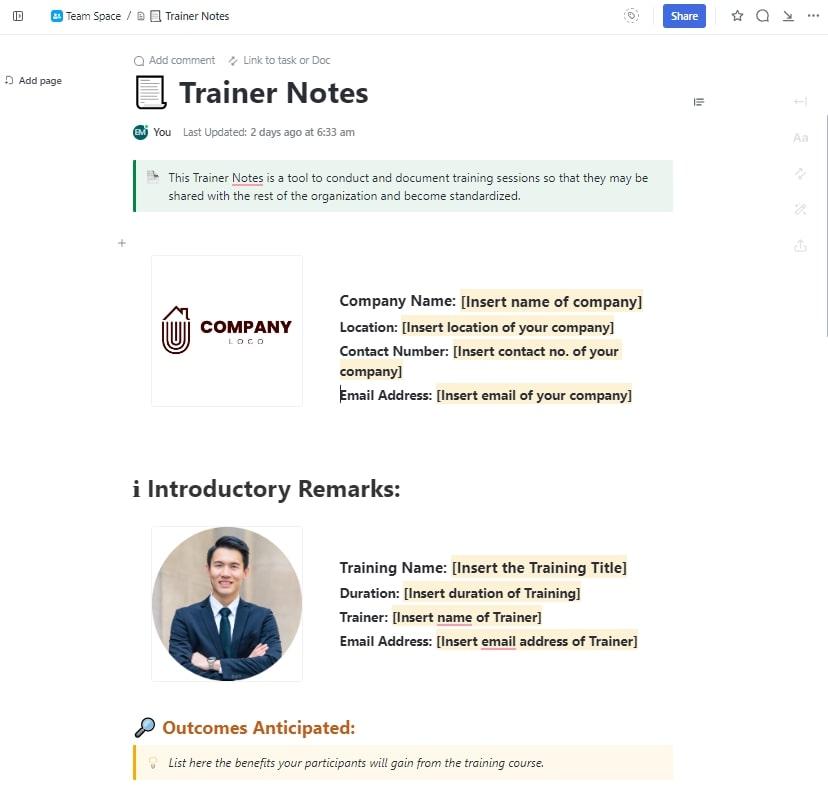هل شعرت يومًا بالإرهاق بسبب كومة من الملاحظات الفوضوية بعد جلسة عصف ذهني مكثفة؟ فجلسات تدوين الملاحظات الفوضوية تقضي على الغرض الأساسي من تدوين الملاحظات. يمكن أن ينتهي بك الأمر بفوضى غير منظمة إذا كنت لا تعرف كيفية تنظيم الملاحظات.
تقودك الملاحظات غير المنظمة إلى تفويت المعلومات الهامة والعناصر التي يجب القيام بها، مما يعيق الإنتاجية واتخاذ القرارات الفعالة.
وسواء كنت تدوّن ملاحظاتك الورقية أو الملاحظات الرقمية، فإن الحل يكمن في تعلم كيفية تنظيم الملاحظات بفعالية. لقد أنشأنا دليلاً يحتوي على عشر تقنيات لتنظيم ملاحظاتك، وتحويل هذه المستندات إلى مصدر قوي للكتابة للرجوع إليها بشكل أسرع.
## فوائد تنظيم ملاحظاتك
يأتي تنظيم ملاحظاتك بمجموعة من الفوائد مثل:
- زيادة الإنتاجية: الملاحظات المنظمة توفر الوقت من خلال تسهيل العثور على المعلومات والرجوع إليها. وفقًا لتقرير ماكينزي، يقضي الموظفون ما يقرب من 20% من أسبوع عملهم في البحث عن المعلومات الداخلية. يمكن أن تقلل ملاحظاتك من هذا الوقت بشكل كبير وتتيح لك التركيز أكثر على المهام الإنتاجية
- تحسين الذاكرة والاحتفاظ بالمعلومات: من الحقائق المثبتة أن تدوين الملاحظات المنظم يحسن الفهم والاحتفاظ بالمعلومات. إن صياغة النقاط بطريقة واضحة ومدروسة تجعل من السهل مراجعة الملاحظات وتذكر النقاط المهمة لاحقًا
- اتخاذ قرارات فعّالة: توفر الملاحظات الواضحة والمنظمة جيدًا موردًا قويًا لاتخاذ قرارات مستنيرة. فالمعلومات التي يسهل الوصول إليها والمنظمة بشكل منطقي تجعل من السهل تحليل البيانات واستخلاص استنتاجات دقيقة
- تجنّب التحميل الزائد للمعلومات: الحفاظ على تنظيم ملاحظاتك يعني تدوين النقاط الرئيسية فقط وتلخيص المعلومات الأساسية بكلمات أقل. ويضمن لك استخدام طرق تدوين الملاحظات لتنظيم ملاحظاتك عدم المعاناة من الحمل الزائد للمعلومات
- تعزيز التعاون: تتيح منصات تدوين الملاحظات المشتركة إمكانية التعاون السلس، مما يضمن أن يكون أعضاء فريقك على نفس الصفحة
## 10 طرق لتنظيم ملاحظاتك
لقد أنشأنا دليلاً يحتوي على أفضل عشر طرق لتنظيم ملاحظاتك طرق تدوين الملاحظات للأفراد والفرق
1. السبورة الرقمية

يعمل ClickUp's Whiteboard من ClickUp على تطوير ممارساتك العامة في تدوين الملاحظات إلى أسلوب أكثر تفاعلية وإبداعًا
الملاحظات الورقية أصبحت من الماضي. استخدم السبورة البيضاء الافتراضية للحفاظ على إمكانية الوصول إلى ملاحظاتك وتعديلها أو التوسع فيها بسهولة في أي وقت.
انقر فوق السبورة البيضاء
يتيح لك العصف الذهني للمشاريع والأفكار مع أدوات إضافية لوضع الاستراتيجيات عبر المخططات الانسيابية. يمكنك استخدام رسم الخرائط لربط المؤشرات المرتبطة في ملاحظاتك المرئية، وإضافة
وتعريف سير العمل.
يمكنك أيضًا تصنيف ملاحظاتك وإضافة مخصصات لمهام محددة. هذه القدرات المتشعبة والتخصيص تجعل من ClickUp Whiteboards مناسبة لسير العمل السريع.
قم بإنشاء مهام من داخل ملاحظاتك وسد الفجوة بين المفاهيم والنتائج. ضع في اعتبارك إضافة سياق إلى ملاحظاتك من خلال الوظائف الإضافية مثل الصور والملفات والمستندات وغيرها. يمكنك الرسم بشكل حر وربط أفكارك بشكل إبداعي للحصول على مخرجات مثالية.
2. مفكرة رقمية

سجل الملاحظات السريعة والنقاط الرئيسية والأفكار الجديدة والتذكيرات باستخدام ClickUp Notepad
تعمل دفاتر الملاحظات الرقمية على تحسين كفاءة تدوين الملاحظات من خلال ميزات مثل وضع العلامات والتصنيف وقدرات البحث القوية، مما يسهل تحديد موقع المعلومات بسرعة.
وهي تدعم هيكلية هرمية مع مجلدات مختلفة أو دفاتر ملاحظات منفصلة لسير عمل منظم بشكل جيد وتوفر مزامنة سحابية وتوافقًا عبر المنصات للوصول إليها في أي وقت وفي أي مكان. كما تسهل دفاتر الملاحظات الرقمية أيضاً التعاون في الوقت الحقيقي، والتحكم في الإصدار، وتكامل الوسائط المتعددة.
ClickUp Notepad
هو مدوِّن الملاحظات الرقمي المثالي مع أدوات تحرير مقنعة ومهام قابلة للتتبع ووصول عن بُعد. يساعدك على تصميم قوائم تدقيق خالية من الفوضى واستخدام أدوات تنسيق عالمية للحصول على ملاحظات رقمية منظمة بشكل جيد.
تساعد وظيفة السحب والإفلات في تنظيم عناصر العمل بينما تساعدك خيارات التنسيق مثل التعداد النقطي والأنماط المختلفة ورموز الألوان والعناوين على إنشاء تسلسل هرمي مرئي. يضمن لك ذلك الحفاظ على تركيزك على مهامك، حتى في أيام المواعيد النهائية.
يمكن الوصول إلى ClickUp من الهواتف الذكية أو متصفحات الويب، ويضمن لك تدوين الملاحظات أثناء الاجتماعات عن بُعد أو المكالمات العفوية.

تحويل ملاحظة إلى مهمة باستخدام ClickUp Notepad ClickUp Notepad
ClickUp Tasks
يسمح لك بتحويل الملاحظات إلى مهام، مع ملخصات ومواعيد نهائية، مما يسهّل سير عملك.
3. المستندات التعاونية

استخدم وضع التركيز وتفاصيل وإعدادات الصفحة المتقدمة وميزات الأرشيف لجعل ClickUp Docs مفكرتك الجديدة المفضلة
يعد استخدام المستندات التعاونية طريقة فعالة لتنظيم الملاحظات، خاصة للفرق. فهي تتيح التعاون في الوقت الفعلي، وتتبع التغييرات باستخدام التحكم في الإصدار، و تجعل المعلومات مركزية حتى يتمكن الجميع من الوصول إلى آخر التحديثات.
كما أنها تعزز كفاءة سير العمل من خلال التكامل مع أدوات الإنتاجية الأخرى.
أنشئ مستندات بالتعاون مع فريقك باستخدام ClickUp Docs
ClickUp Docs
تنقل تدوين الملاحظات التعاونية إلى المستوى التالي. فهي تتيح لك تدوين الملاحظات وتداخل الصفحات مع العشرات من خيارات التصميم عبر القوالب. تساعدك الجداول وتسهيلات التنسيق الموسعة على تنظيم ملاحظاتك المبعثرة بشكل أفضل.
على سبيل المثال، يمكن للمستندات تحويل الملاحظات إلى محاور معرفية لموضوعات محددة وخرائط طريق لسير عمل العمليات.
والأفضل من ذلك هو كيفية ربط المستندات بالمهام في ClickUp لإنشاء مهام سير عمل مفصلة وتتبع جميع نقاط بياناتك في مكان واحد. تعمل الأدوات الإضافية على تسهيل تتبع سير العمل ويمكنها تخصيص المهام مع ملخصات كاملة ومواعيد نهائية وأولويات.
بالإضافة إلى ذلك، يجمع مركز المستندات جميع ملاحظاتك ويصنفها في قاعدة بيانات واحدة، يمكن لفريقك الوصول إليها عبر مرشحات لفرز أو البحث عن أصول محددة.
يضمن هذا النهج الشامل تنظيم ملاحظاتك بشكل جيد وسهولة الوصول إليها ودمجها في سير عملك.
4. هيكلة الملاحظات المدعومة بالذكاء الاصطناعي
تعمل أدوات الذكاء الاصطناعي على إحداث ثورة في كيفية تدوين الملاحظات وتنظيمها، حيث توفر إمكانات تتجاوز بكثير الأساليب التقليدية التي تعتمد على القلم والورق. فهي توفر تلخيصاً فائق السرعة، والتكامل السلس مع المهام، والقدرة على إنشاء مستندات وعروض تقديمية مخصصة دون عناء.
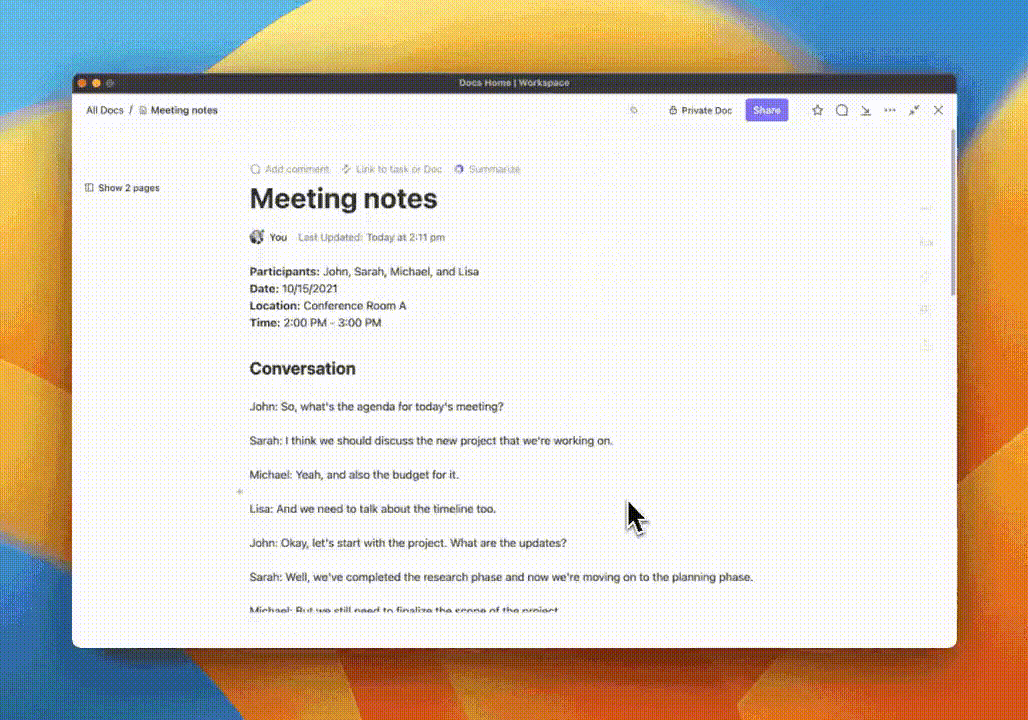
تلخيص ملاحظات الاجتماعات، والبحث عن معلومات محددة، وأتمتة المهام اليدوية باستخدام ClickUp Brain ClickUp Brain تجسد قدرات الذكاء الاصطناعي هذا التحول. إنه يلخص بسرعة يلخص ملاحظات الاجتماع دون إدخال يدوي، مما يتيح لك إعادة استخدام المواد في رسائل البريد الإلكتروني أو المستندات أو الخطوط العريضة للعروض التقديمية.
يعمل نموذج الشبكة العصبية هذا على مزامنة ملاحظاتك مع كل شيء من مهامك ومستنداتك والمتعاونين معك ومراكز بيانات الشركة. يمكنك طرح أسئلة عليه حول ملاحظاتك أو مهامك واستخدامه لإنشاء تدفقات عمل لمشاركة التحديثات مع أصحاب المصلحة، وما إلى ذلك. علاوة على ذلك، يساعدك على استخدام ملاحظاتك لتطوير محتوى مكتوب بسرعة بمساعدة مساعد الذكاء الاصطناعي.
وباختصار، يتيح لك استخدام ClickUp Brain في جلسات تدوين ملاحظاتك ربط الملاحظات بمنتجات الشركة وخطط العمل وملخصات المشاريع وجوانب تخطيط المشاريع.

استخدم مساعد الذكاء الاصطناعي للعقل في ClickUp لتصحيح الإملاء والإجابة عن الأسئلة الشائعة حول ملاحظاتك والحصول على توجيه فوري بشأن الشكوك
تذكّر أن
أدوات الذكاء الاصطناعي لتدوين الملاحظات
تتفوق بسرعة على آليات تدوين الملاحظات التقليدية التي تعتمد بشكل أكبر على أنظمة القلم والورق.
5. قوالب تدوين الملاحظات
تنظيم الملاحظات باستخدام
يتضمن اختيار قالب يناسب احتياجاتك، مثل جدول أعمال اجتماع، أو مخطط تفصيلي لمشروع، أو دفتر يوميات أو دليل دراسة.
توفر هذه القوالب تنسيقًا منظمًا، مما يضمن الاتساق ويسهل تصنيف الأفكار الرئيسية واسترجاعها بسرعة.
علاوة على ذلك، يساعد استخدام القوالب في الحفاظ على نفس التنسيق عبر الملاحظات المختلفة، مما يعزز التنظيم والكفاءة بشكل عام.
قالب ملاحظات الفصل
قالب ClickUp لتدوين الملاحظات لملاحظات الفصل الدراسي هو مستند ClickUp المصمم مسبقًا لتحسين عملية تدوين الملاحظات من خلال هيكل سهل الاستخدام يمكن للطلاب تطبيقه على مختلف المواد الدراسية وأي أسلوب تعليمي.
يساعد الطلاب والمعلمين على تنظيم ملاحظات الفصل الدراسي لتسهيل الرجوع إليها في المستقبل. يمكنك حفظ الروابط المهمة وملاحظات الواجبات المنزلية والملاحظات داخل الفصل دون الحاجة إلى الفرز المتكرر بين المستندات المزدحمة.
تم تصميم بنية هذا القالب لمساعدتك على تصنيف ملاحظاتك بسهولة. بالإضافة إلى التصنيف السريع، يمكنك استخدام خيارات التنسيق لتخصيص العناوين وفقًا لتفضيلاتك الجمالية.
استخدم جدول المحتويات المدمج للوصول إلى أقسام مختلفة من ملاحظاتك. هذا يجعل الوصول إلى الصفحات المختلفة أبسط بكثير ويوفر الوقت المستغرق في تقليب الصفحات. يمكنك أيضًا تضمين روابط وإنشاء مهام لتحسين عمق ملاحظاتك.
لا تتردد في تسليط الضوء على الأقسام كشكوك أو إضافة تعليقات كدليل داعم لمعلوماتك المجمعة. اختبر ميزة المفكرة المثبتة في أسفل هذا القالب. تساعدك وظيفتها أثناء التنقل على تدوين أفكار المشروع ونقاط البيانات الرئيسية بسرعة. تنزيل هذا القالب
قالب الملاحظات اليومية
تم تصميم قالب الملاحظات اليومية من ClickUp لمساعدتك على تتبع الملاحظات والمهام اليومية في مكان واحد.
قالب الملاحظات اليومية لـ ClickUp
يتيح لك تنظيم ملاحظاتك الرقمية لضمان توثيق معلوماتك المكتسبة وتخزينها بأمان. اعتبره وجهة واحدة لملخصات العميل وتحديثات المشروع وقوائم المراجعة الشخصية وغيرها من الأنشطة اليومية التي تدون ملاحظاتك بشأنها.
يقدم قالب تدوين الملاحظات هذا ثلاث طرق عرض لتصور ملاحظاتك وتلخيص أحدث جلسات جمع المعلومات. ابقَ على المسار الصحيح من خلال تحديد أولويات المؤشرات المحددة في ملاحظاتك وحلها وفقًا لمدى إلحاحها. يمكنك استخدام ميزة تتبع التقدم المحرز لتحديد أهداف قابلة للتحقيق وتعديل أهدافك اليومية بناءً على عبء العمل الخاص بك. تنزيل هذا القالب
قالب ملاحظات المدربين
تم تصميم قالب ملاحظات المدرب في ClickUp لمساعدتك على تتبع جميع المعلومات المتعلقة بالتدريب.
قالب ملاحظات المدرب الخاص ب ClickUp
هو الأفضل لتدوين الملاحظات الأساسية أثناء جلسات التدريب وتوحيدها في مؤسستك. إلى جانب منح جلساتك التدريبية انسيابية أفضل، تم تصميم هذا القالب لتوثيق الملاحظات المهمة بصيغة سهلة الفهم.
يمكنك أيضًا جمع الملاحظات القابلة للتنفيذ من فريقك وتنفيذ التغييرات اللازمة على وثائق التدريب.
لاحظ قسم جدول المحتويات. يمكنك تخصيص عناوين لكل قسم من أقسام ملاحظاتك لتبسيط الرجوع إليها. تنزيل هذا القالب
قالب نمط ملاحظات الاجتماعات
تم تصميم قالب نمط ملاحظات الاجتماعات من ClickUp لمساعدتك في تدوين الملاحظات أثناء الاجتماعات وتتبع المحادثات.
تم إنشاؤه خصيصاً لتدوين الملاحظات أثناء الاجتماعات,
قالب نمط ملاحظات الاجتماعات الخاص ب ClickUp
يساعدك على تلخيص المعلومات التي تمت مشاركتها في أجزاء سهلة الهضم. يعمل القالب على تبسيط كيفية تسجيل الأفكار الحيوية وقرارات الفريق، مما يسمح لك بتتبع الملاحظات السابقة وتتبع عمليات اتخاذ القرار.
تذكر أنه يمكنك أيضًا تجميع أجزاء محددة من ملاحظاتك من الاجتماعات السابقة للمراجعة السريعة. تنزيل هذا القالب
قالب مذكرة المشروع
صُمم قالب مذكرة المشروع من ClickUp لمساعدتك في تسجيل وتنظيم الأفكار الخاصة بالمشروع.
يمكن أن يصبح الحل المفضل لديك لإنشاء ملاحظات المشروع وتتبعها.
يتيح تصميمه القابل للتخصيص بالكامل لفريقك البقاء مستعدًا طوال دورة حياة المشروع من خلال جمع الملاحظات وإحاطة المحتوى وتسهيلات تتبع التقدم المحرز. تنزيل هذا القالب
6. استخدم البطاقات التعليمية
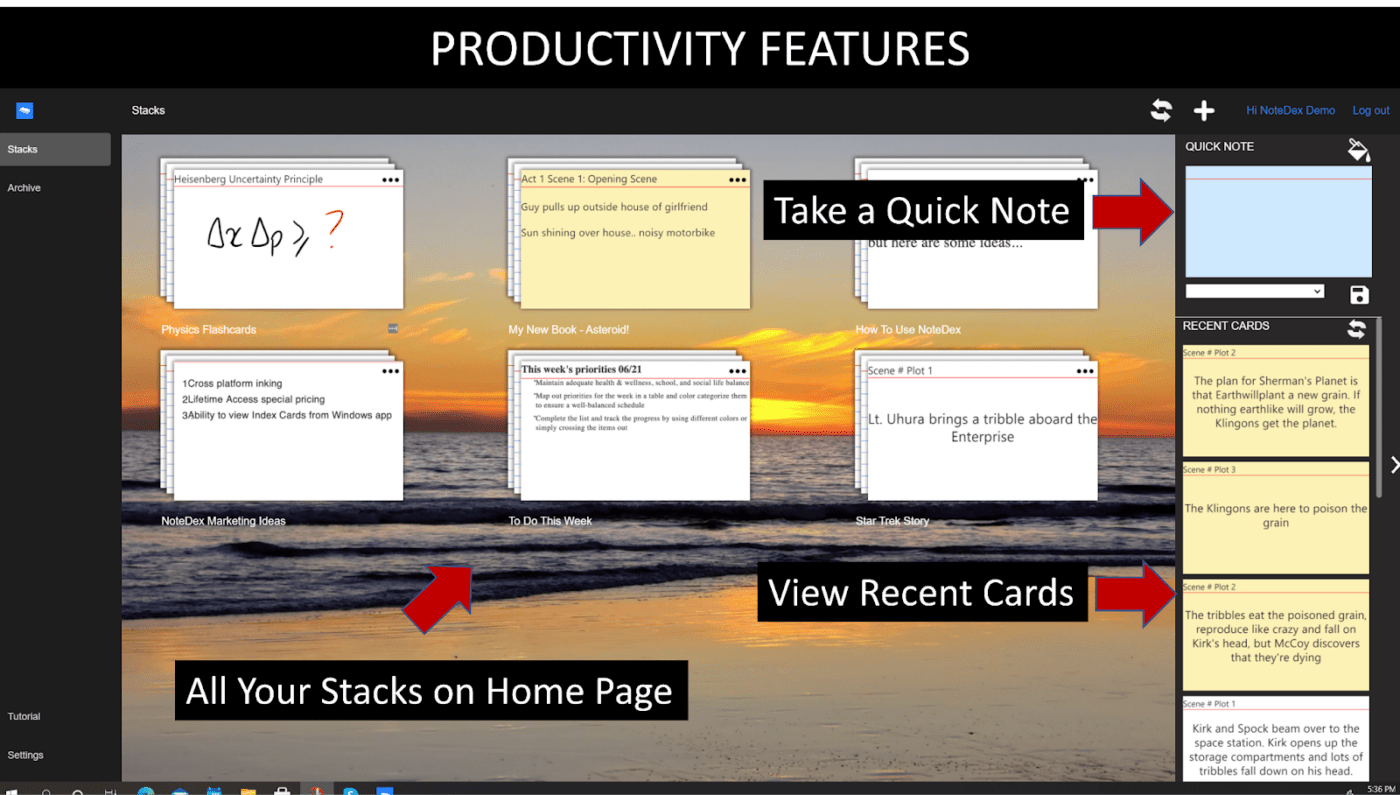
عبر:
إن مجرد تنظيم ملاحظاتك ليس نهاية المطاف لنظام قوي لحفظ الملاحظات. يعتمد العديد من المحترفين على البطاقات التعليمية لتنظيم ملاحظاتهم بأشكال محددة أو دراسة البيانات بشكل أكثر دقة.
استخدم الترميز اللوني لـ تصنيف البطاقات التعليمية إلى أقسام التفكير والتنفيذ والمراجعة. وبالمثل، يمكنك إضافة مخططات أو أيقونات لشرح الغرض الأساسي من كل بطاقة تعليمية.
حاول استخدام جانب واحد من البطاقة التعليمية لإبراز المفهوم أو الموضوع الرئيسي. يمكن أن يحتوي الوجه الخلفي على تفاصيل مفصلة خاصة بما هو موجود في المقدمة.
وأخيرًا، ابحث عن تطبيق للهواتف الذكية لتحسين ممارسات الاحتفاظ بالذاكرة من خلال نظام تدوين الملاحظات هذا. ابحث عن AnkiApp و Quizlet و Flashcards World.
7. إنشاء الرسوم البيانية

عبر
يمكن أن يكون استخدام طريقة التخطيط لتنظيم الملاحظات فعالاً للغاية. يمكنك إنشاء مخططات من خلال إدراج المواضيع الرئيسية كصفوف على اليسار والمواضيع الفرعية كأعمدة في الأعلى.
أو بدلاً من ذلك، ارسم محور س ومحور ص لتقسيم ملاحظاتك إلى أربعة أرباع للأقسام الكمية والنوعية والمراجعة والتفكير. يمكنك أيضًا استخدام المخططات الدائرية لتمثيل بياناتك بشكل مرئي وجذاب.
تسهل المخططات دراسة المعلومات لأنها تعرضها في شكل واضح وممتع من الناحية الجمالية.
8. تصميم الخرائط الذهنية
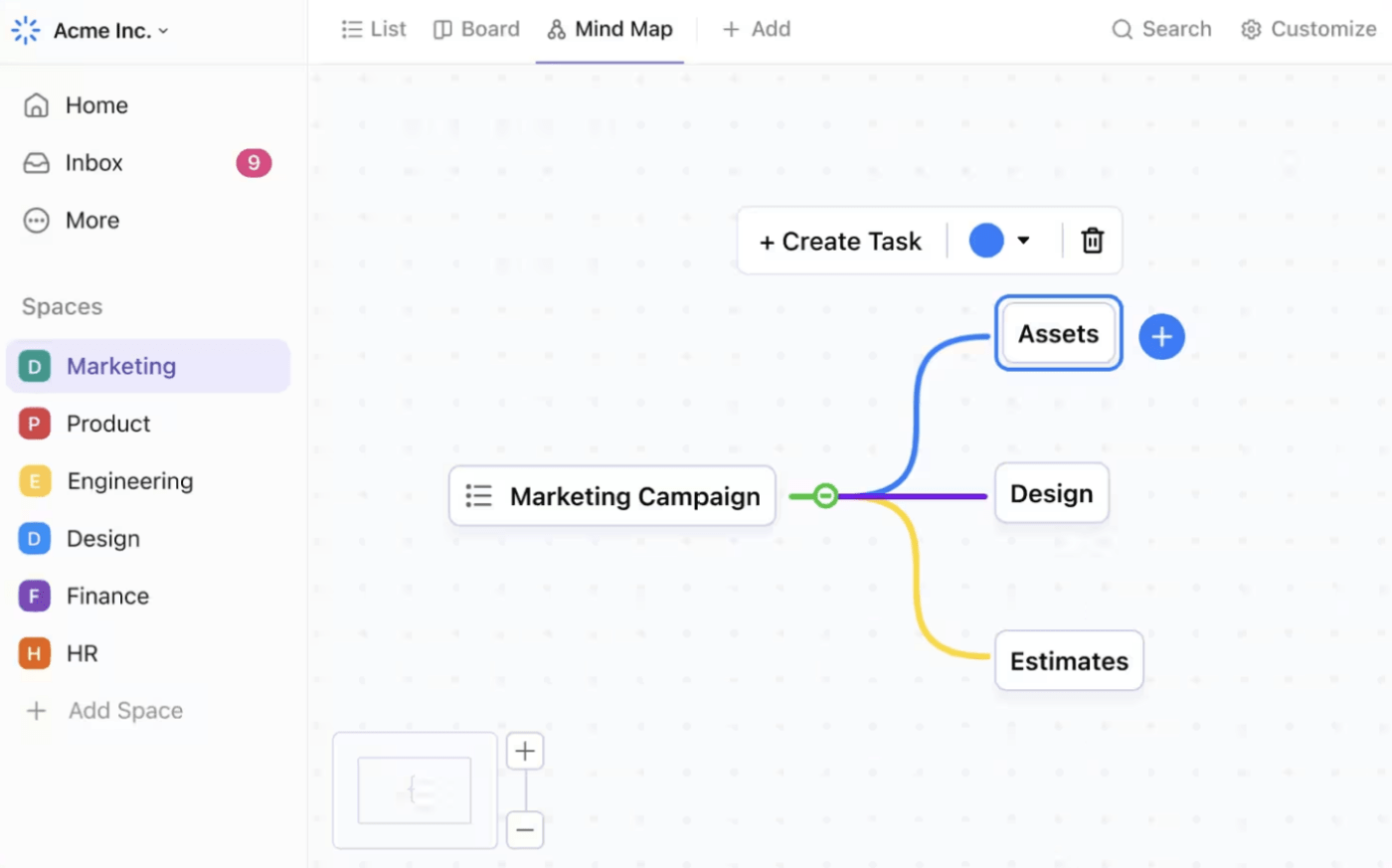
ربط الأفكار الكبيرة المختلفة بفكرة مركزية واحدة باستخدام ClickUp MindMaps
هذه
تقنية تدوين الملاحظات على الخريطة الذهنية
يناسب ربط طبقات متعددة من الأفكار. على سبيل المثال، اكتب موضوعك الأساسي في مربع في وسط الصفحة. ثم تفرع لإضافة دوائر ومثلثات للموضوعات الفرعية ونقاط البيانات ذات الصلة.
يمكنك أيضًا تعيين غرض محدد لكل شكل لضمان عدم تعطل تدفق الأفكار بسبب أشكال المعلومات المختلفة. ضع في اعتبارك اتباع ترتيب في اتجاه عقارب الساعة لتجنب الارتباك بسبب تعدد العناصر في خريطتك الذهنية.
سيبدو المنتج النهائي كشبكة مترابطة من ملاحظاتك التي تقدم خاتمة أو تؤكد على الأمور التي تحتاج إلى اهتمام فوري.
9. جرب طريقة كورنيل
فكرة
هي تقسيم الهيكل العظمي لملاحظات محاضرتك إلى ثلاثة أجزاء: الملخص، والملاحظات، والإشارة. تكون منطقة تدوين الملاحظات هي الأكبر، يليها عمود الملاحظات الذي يأخذ حوالي ثلث صفحتك وقسم الملخصات في الأسفل.
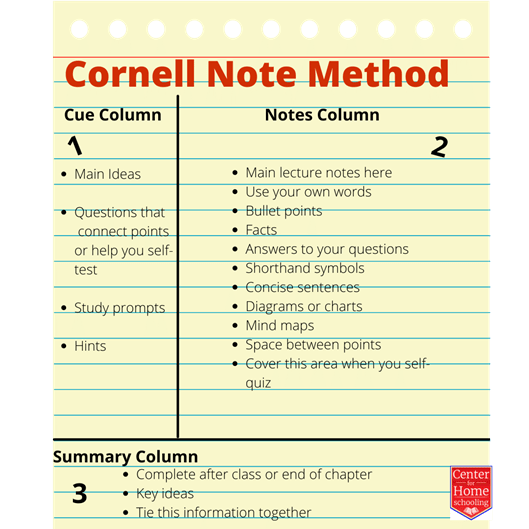
عبر
اجمع هذه الطريقة مع طريقة تدوين الملاحظات الخمسة وهي
- التسجيل: استخدم العمود الرئيسي لتسجيل المعلومات والحقائق الثاقبة التي تتحدث عن موضوعك
- اختصر: اختصر هذه البيانات في عمود التدوين. وهذا يساعدك على إنشاء إحساس بالاستمرارية وفهم أركان موضوعك
- إعادة التكرار: هدفك هنا هو تكرار ما تعلمته من أول عمودين والتحقق مرة أخرى مما إذا كنت على نفس الصفحة
- التأمل: كوّن آرائك حول الموضوع واستخدمها لبدء كيفية التخطيط لتطوير مشروعك من الآن فصاعداً
- المراجعة: استمر في مراجعة ملاحظاتك لمدة 10-15 دقيقة/الأسبوع لتدوين النتائج الجديدة وتلخيص ما تعلمته
10. نشر تقنيات تدوين الملاحظات المرئية
يمكن لتقنيات تدوين الملاحظات المرئية أن تحول ملاحظاتك إلى محتوى جذاب لا يُنسى. استخدم الرسومات والرموز وتنسيق النصوص المتنوعة لجعل ملاحظاتك جذابة بصريًا.
بدلاً من تدوين الملاحظات كلمة بكلمة، قم بتضمين عناصر مرئية مختلفة مثل الروابط والصور.
هذا النهج لا يجعل ملاحظاتك المكتوبة بخط اليد أكثر تشويقًا فحسب، بل يساعد أيضًا في الاحتفاظ بالمعلومات بشكل أفضل.
تشير الدراسات إلى أن العناصر المرئية
يمكن أن تعزز الذاكرة والفهم، مما يجعل ملاحظاتك أكثر فعالية من الملاحظات التقليدية تطبيقات تدوين الملاحظات والأنماط
اقرأ أيضًا:
اعتمد نظامًا حديثًا لتدوين الملاحظات لتبقى منظمًا
يعزز الإنتاجية ويحسن عملية اتخاذ القرار.
إن الاحتفاظ بملاحظاتك منظمة ويسهل الوصول إليها يحولها إلى أداة قوية للنجاح في الإعدادات الفردية والجماعية.
فكّر في دمج أداة قوية لإدارة المشاريع مثل ClickUp في سير عملك. فقد تم تصميم مجموعة الميزات الموسعة الخاصة بها لتبسيط عمليات تدوين الملاحظات والتنظيم، مما يجعل إدارة المهام وتتبع التقدم المحرز والتعاون بسلاسة أكثر بساطة.
وباستخدام ClickUp، يمكنك جعل جميع ملاحظاتك مركزية ومشاركتها عبر الأقسام والطبقات التنظيمية للحفاظ على توافق الأعضاء المعنيين وتركيزهم. جرّب ClickUp مجاناً واختبر الفرق الذي يمكن أن تحدثه الملاحظات المنظمة!




